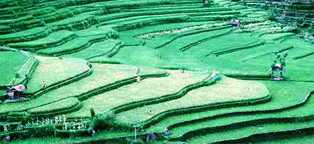DESTINATION BALI Bali is so picturesque that you could be fooled into thinking it was a painted backdrop: rice paddies trip down hillsides like giant steps, volcanoes soar through the clouds, the forests are lush and tropical, and the beaches are lapped by the warm waters of the Indian Ocean. But the postcard paradise gloss has been manufactured and polished by the international tourist industry rather than by the Balinese themselves - who don't even have a word for paradise in their language - and it pays scant regard to the hard reality of life on Bali, which is currently suffering the fallout of Indonesia's economic crisis and collapsing currency. Bali remained calm in 1998 while many islands in the archipelago expressed their anger at the economic and political situation. Though tourism took a downturn in the first half of this year, visitors have flocked to the island in droves over the past 20 years. The Balinese have been remarkably resilient in the face of mass tourism and 'I've-been-to-Bali-too' T-shirts: once you're away from lurching Aussies with a scary thirst for beer, you'll find locals living in traditional houses and participating in a timeless round of religious rituals and rice cultivation. In fact, the Balinese seem to handle tourism better than some of the tourists, many of whom are happy to be able to get a Coke but seem disappointed that they're not the only ones sucking back the real thing. The locals' welcoming and stoic stance can at least partly be attributed to a long history of absorbing, and profiting from, foreign influences. Since the 15th century, when the Java-based Majapahit dynasty retreated here, and onward through Portuguese and Dutch traders, invaders and colonisers, the Balinese have been dealing with interlopers and taking fresh ideas on board while maintaining rich traditions of music, dance, visual arts, architecture and religion. |


 Facts at a Glance
Facts at a Glance When to Go
When to Go Events
Events Attractions
Attractions
 Off the record
Off the record Off the Beaten Track
Off the Beaten Track Getting There & Away
Getting There & Away Getting Around
Getting Around Lonely Planet Guides
Lonely Planet Guides Travellers' Reports
Travellers' Reports On-line Info
On-line Info